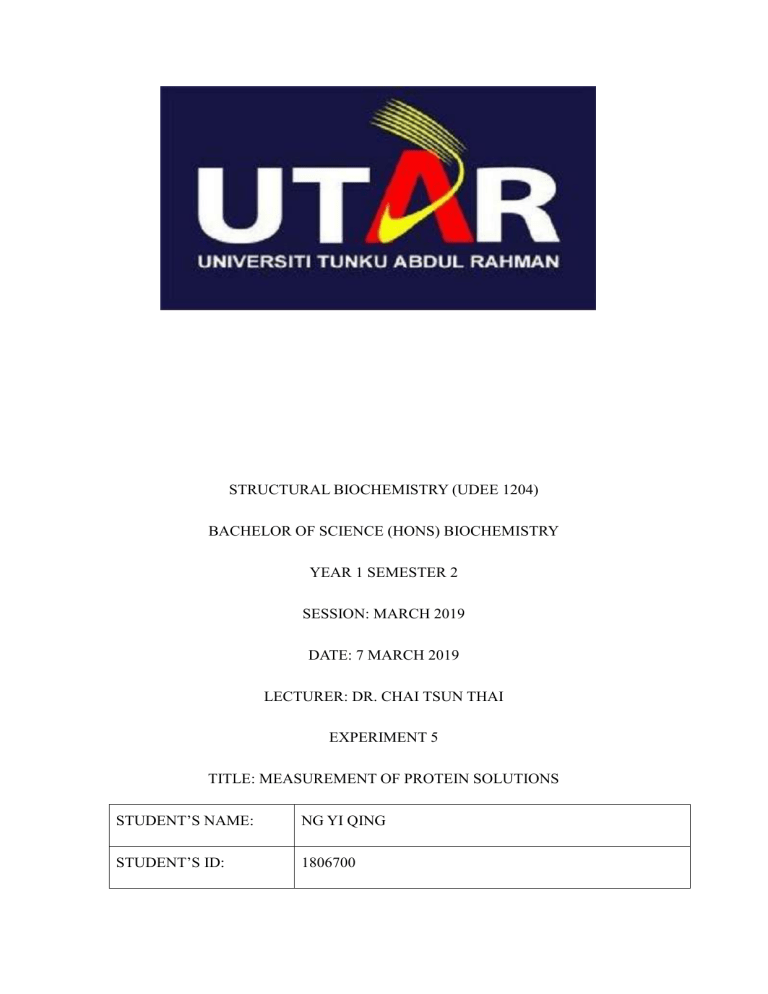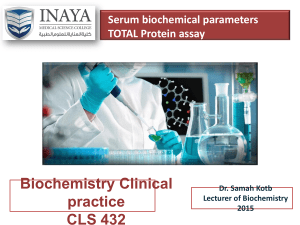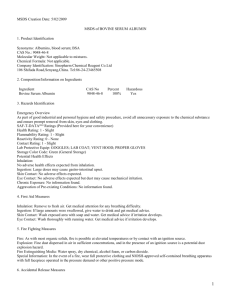
STRUCTURAL BIOCHEMISTRY (UDEE 1204) BACHELOR OF SCIENCE (HONS) BIOCHEMISTRY YEAR 1 SEMESTER 2 SESSION: MARCH 2019 DATE: 7 MARCH 2019 LECTURER: DR. CHAI TSUN THAI EXPERIMENT 5 TITLE: MEASUREMENT OF PROTEIN SOLUTIONS STUDENT’S NAME: NG YI QING STUDENT’S ID: 1806700 LAB PARTNERS: 1. LOW SHEAU TONG 1706117 2. CHEAH HUI LE 1703931 3. YONG CHIA XIN 1703855 Title: Measurement of Protein Solutions Objective: 1. To learn the measurement of protein solutions. 2. To investigate the difference between color change of peptide bond and Biuret compound. Introduction: Proteins are large biomolecules, or macromolecules, consisting of one or more long chains of amino acid residues. Proteins perform a vast array of functions within organisms, including catalysing metabolic reactions, DNA replication, responding to stimuli, providing structure to cells and organisms, and transporting molecules from one location to another. Protein is also a macronutrient that is essential to building muscle mass (Szalay,J.2019).Proteins in particular are a biochemical compound that need to be measured oftenly. Due to the presence of tyrosine and tryptophan, proteins and peptides containing these aromatic amino acids absorb UV light at a wavelength of 280 nm (Protein Man,T.2019). Most pure protein solutions containing 1 mg/mL of protein have an absorbance of about 1.0 when the light path is 1 cm. This method is simple, rapid, and allows for full recovery of the protein. However, an accurate quantitation will be difficult due to many other biochemical absorb near this wavelength. Furthermore, the absorbance of different proteins will be different extents depending on their aromatic amino acid. The biuret test, also known as Piotrowski's test, is a chemical test used for detecting the presence of peptide bonds and avoiding the problem above. It is made of sodium hydroxide and copper sulphate. In the presence of peptides, a copper(II) ion forms mauve-colored coordination complexes in an alkaline solution. Material & Method: Spectrophotometer, test tubes, pipettes, vortex, Bovine serum albumin (BSA), Biuret reagent A stock solution of bovine serum albumin (10mg/mL) is being used, serial dilution of 2,4,6,8, and 10mg/mL is prepared. (Final volume for each tune is 1mL) ↓ 9mL Biuret reagent is added to each tube, it is vortexed immediately, and is let stand at room temperature for 20 minutes. ↓ 1mL of the sample labelled UNKNOWN is pipetted to a test tube and step 3 is repeated. ↓ The absorbance is read at 550nm and spectrophotometer is being used. ↓ A graph of absorbance versus concentration is plotted and the concentrations of the UNKNOWN samples are determined from the curve. Results: Bovine serum Volume of Volume of Volume of Absorbance of albumin BSA stock water (μL) Biuret reagent 550nm (mg/mL) (μL) 0 0 1000 2 200 800 ↑ 0.165 4 400 600 9000 0.229 6 600 400 ↓ 0.289 8 800 200 0.336 10 1000 0 0.371 Unknown ○,1Biuret reagent provided ○,21000μL sample (μL) 0.000 0.231 + 9000μL Biuret ↓ Mix ↓ Stand 15 min ↓ OD550nm ○,3Bovine serum albumin (BSA) → 1% = 1/1000mLg = 1000mg/100mL = 10mg/mL M1V1 = M2V2 10mg/mL x V1 = 2mg/mL x 1000μL V1 = (2 x 1000) / 10 = 200μL M1V1 = M2V2 For 0mg/mL, 10mg/mL x V1 = 0mg/mL x 1000μL V1 = (0 x 1000) / 10 = 0μL For 2mg/mL, 10mg/mL x V1 = 2mg/mL x 1000μL V1 = (2 x 1000) / 10 = 200μL For 4mg/mL, 10mg/mL x V1 = 4mg/mL x 1000μL V1 = (4 x 1000) / 10 = 400μL For 6mg/mL, 10mg/mL x V1 = 6mg/mL x 1000μL V1 = (6 x 1000) / 10 = 600μL For 8mg/mL, 10mg/mL x V1 = 8mg/mL x 1000μL V1 = (8 x 1000) / 10 = 800μL For 10mg/mL, 10mg/mL x V1 = 10mg/mL x 1000μL V1 = (10 x 1000) / 10 = 1000μL Absorbance at 550nm 0,45 0,4 0,35 0,3 0,25 0,2 0,15 0,1 0,05 0 4,98; 0,231 0 2 4 6 8 Bovine serum albumin (mg/mL) 10 12 Discussion: The presence of amino and carboxylic acid groups enables amino acids to accept protons from and donate protons to aqueous solution, and, therefore, to act as acids and bases. Because proteins contain both acidic and basic side-chains, they too can donate or accept protons. A molecule that functions simultaneously as an acid and a base is known as an amphoteric molecule. The biuret test for proteins positively identifies the presence of proteins in solution with a deep violet color. Biuret, H2NCONHCONH2, reacts with copper (II) ions in a basic solution to form a deep violet complex (Kumar,P.2019). From the experiment above, we have read the absorbance at 550nm using different bovine serum concentration. 10mg/mL of bovine serum albumin and distilled water is used to create different concentration of sample. The Biuret reagent solution is let to stand for 15 minutes after dilution. From the results obtained from spectrophotometer, more proteins will be absorbed indicates greater absorbance due to the higher concentration of the sample. The graph plotted shows the absorbance at 550nm is slightly directly proportional to the bovine serum albumin concentration. Furthermore, the reading of spectrophotometer at OD550 for unknown bovine serum that showed from the graph is 0.231, thus the concentration of unknown bovine serum albumin is 4.98mg/mL. Conclusion: In conclusion, different concentration of sample will lead to different absorbance of 550nm. The graph of absorbance versus concentration is plotted according to the table. The graph is slightly directly proportional to the bovine serum albumin concentration. The reading of spectrophotometer at OD550 for unknown bovine serum that showed from the graph is 0.231 and the concentration is 4.98mg/mL. In accordance, the range concentration of unknown bovine serum is between 4-6mg/mL. References: 1. Szalay, J. (2019). What Is Protein?. [online] Live Science. Available at: https://www.livescience.com/53044-protein.html [Accessed 10 Dec. 2015]. 2. Protein Man, T. (2019). Why Does Tyrosine and Tryptophan Have Effect in Protein Determination and to What Degree?. [online] Info.gbiosciences.com. Available at: https://info.gbiosciences.com/blog/why-does-tyrosine-and-tryptophan-have-effectin-protein-determination-and-to-what-degree [Accessed 17 Feb. 2016]. 3. Kumar, P. (2019). Qualitative and Quantitative Tests for Amino Acids and Proteins. [online] Biology Discussion. Available at: http://www.biologydiscussion.com/proteins/qualitative-and-quantitative-tests-foramino-acids-and-proteins/13065 [Accessed 9 Mar. 2019].

